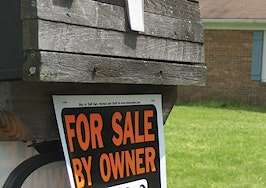Are you set up for success in 2016? Join 2,500 real estate industry leaders Aug. 4-7, 2015, at Inman Connect in San Francisco. Get Connected with the people and ideas that will inspire you and take your business to new heights. Register today and save $100 with code Readers.
When prices soar, as they are right now, sellers are supposed to get off the fence and list their homes. No doubt many buyers are doing so, yet inventories are tight in hotter markets, especially in the lower price tiers critical for first-time buyers seeking enter homeownership.
For first-time buyers — and for brokerages hungry for listings — pathetic inventories have become a bigger problem than qualifying for financing or saving for a down payment.
However, the discomfort is more likely a temporary growing pain than a permanent one. The real estate economy is healing from a near-death experience, and recovery will cause dislocations as the pieces are put back together.
Here are four reasons why low inventories are pathetic today but won’t be tomorrow:
1. Too many homeowners still lack the equity to sell, but not for long.
Owners need more cash than the balance they might owe on their mortgage to sell their homes. It can take tens of thousands to get an old home into shape to list. Then there are closing costs such as commission.
That’s why owners who lack more than 20 percent equity in their homes are considered “underequitied,” and they are just as frozen in place as those who owe more on their mortgages than their houses are worth.
CoreLogic estimates 14.8 million homes, or 29.6 percent of all homes with a mortgage, were underequitied at the end of the first quarter. A disproportionate share is homes in the lower price brackets — the very homes in highest demand by first-time homebuyers.
For example, only 85 percent of homes valued at less than $200,000 are above water.
Although some 3.8 percent of owners — 1.9 million homes — have less than 75 percent equity in their homes, the equity situation is continuing to improve.
CoreLogic estimates that each 5 percent increase in home values translates into another 1 million homeowners freed from negative equity.
2. The decline of foreclosures and short sales has greatly reduced lower-priced inventories, but markets are adjusting.
Just three years ago, foreclosures and short sales accounted for 25 percent of all sales. This past May they were only 10 percent.
At the same time, the share of purchases by investors has fallen from 20 percent of sales in April 2012 to 14 percent of existing-home sales last May.
Foreclosure sales will decline even more; foreclosure inventories have declined nearly 25 percent from a year ago. The decline of discounted distress sales has been an excellent thing for the housing economy, though; in a sense, they have propped up inventories and sales.
They are quickly replaced by full-price sales and owner and occupants as the recovery takes hold.
In fact, it’s remarkable that the drying up of distress sales hasn’t caused more problems than they have. The corresponding decline in investor purchases has made the transition easier by reducing demand at the same time that supplies have been shrinking.
3. New construction isn’t filling the right vacuum, but some builders are learning.
New-home construction has been booming, but it’s supplying new inventory to the upper, rather than the lower, half of the market.
Sales of newly built, single-family homes rose 2.2 percent to a seasonally adjusted annual rate of 546,000 units in May, according to newly released data from HUD and the U.S. Census Bureau.
That’s the highest new-home sales rate since February 2008. At that rate, however, new homes will replace only about one of every 10 existing homes sold this year.
New homes have become much more expensive than existing homes. The typical new-home cost is 12.5 percent larger in 2013 than in 2009 and generally costs 10-20 percent more than existing houses.
In recent years, foreclosures have driven down the median price of existing homes, widening the price gap to 40 percent. Last year, the median sales price of new homes stood at $283,000 compared with $208,300 for existing homes.
Some builders are starting to figure out how to make a profit on a lower-priced product, and the market is responding. While new-home sales are hot, lower-priced new-home sales are even hotter.
Americans signed contracts to purchase 17,000 new houses in the $200,000-to-$299,999 price range in February — the most since March 2008. Lower-priced homes represented about 39 percent of all 44,000 new properties sold that month.
4. New “low down” down payment programs are putting pressure on inventories by artificially priming first-time-buyer demand, but they won’t last.
At this juncture, it’s hard to know how much impact the new 3.5 percent down payment programs launched recently by Fannie Mae and Freddie Mac and FHA’s halving of its annual mortgage insurance premium are having on sales.
The GSE programs come with strings attached, and the FHA largesse doesn’t make up for the increases in mortgage insurance premiums and other costs it has imposed on borrowers in recent years.
However, reports from the field indicate the low down program, along with rising interest rates, are pushing first-time buyers off the fence.
That’s a good thing in some quarters, except that Uncle Sam is bearing the cost and at the risk of inciting young buyers without asking for much “skin in the game” in return, i.e., investment in the form of a down payment.
The programs have already raised the ire of Republicans in Congress, and it’s unlikely they will continue in their current form no matter who wins the White House a year from November.
Other market forces are at work in the housing economy that will produce even more prospective buyers. Rents are out of control and driving tenants out.
Millennials who swore on a stack of Bibles that they would rent forever are getting married, having babies and looking for houses to buy.
Incomes are getting better. Folks are getting married, and they are turning two incomes into one household. Financing is very slowly getting easier to obtain.
In time, the inventory will respond to supply and demand — sometimes very slowly, but also very surely. Rising prices will free 10 million homes that are equity-locked today.
Boomers will retire and move to smaller, easier digs. Builders will figure out how to build houses that millennials want.
In fact, it might not be long before we are wringing our hands over the problems excess inventory causes in the marketplace, and we’ll look back at today’s real estate economy with envy.
Steve Cook is editor and co-publisher of Real Estate Economy Watch and provides communications consulting services to leading real estate organizations. Visit him on LinkedIn and Facebook.







